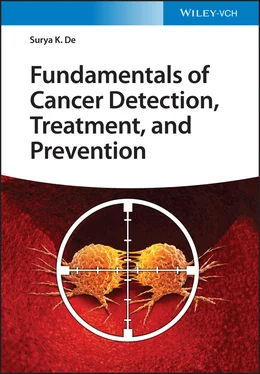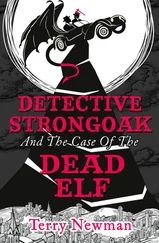Surya K. De - Fundamentals of Cancer Detection, Treatment, and Prevention
Здесь есть возможность читать онлайн «Surya K. De - Fundamentals of Cancer Detection, Treatment, and Prevention» — ознакомительный отрывок электронной книги совершенно бесплатно, а после прочтения отрывка купить полную версию. В некоторых случаях можно слушать аудио, скачать через торрент в формате fb2 и присутствует краткое содержание. Жанр: unrecognised, на английском языке. Описание произведения, (предисловие) а так же отзывы посетителей доступны на портале библиотеки ЛибКат.
- Название:Fundamentals of Cancer Detection, Treatment, and Prevention
- Автор:
- Жанр:
- Год:неизвестен
- ISBN:нет данных
- Рейтинг книги:4 / 5. Голосов: 1
-
Избранное:Добавить в избранное
- Отзывы:
-
Ваша оценка:
- 80
- 1
- 2
- 3
- 4
- 5
Fundamentals of Cancer Detection, Treatment, and Prevention: краткое содержание, описание и аннотация
Предлагаем к чтению аннотацию, описание, краткое содержание или предисловие (зависит от того, что написал сам автор книги «Fundamentals of Cancer Detection, Treatment, and Prevention»). Если вы не нашли необходимую информацию о книге — напишите в комментариях, мы постараемся отыскать её.
The professional guide to cancer diagnosis and therapy for researchers and clinicians Fundamentals of Cancer Detection, Treatment, and Prevention,
Fundamentals of Cancer Detection, Treatment, and Prevention
Fundamentals of Cancer Detection, Treatment, and Prevention — читать онлайн ознакомительный отрывок
Ниже представлен текст книги, разбитый по страницам. Система сохранения места последней прочитанной страницы, позволяет с удобством читать онлайн бесплатно книгу «Fundamentals of Cancer Detection, Treatment, and Prevention», без необходимости каждый раз заново искать на чём Вы остановились. Поставьте закладку, и сможете в любой момент перейти на страницу, на которой закончили чтение.
Интервал:
Закладка:
Medical information changes constantly; hence, the information in this book or on the referenced websites should not be considered current, complete, or exhaustive. Do not rely on this information to select a course of treatment for you or any other individual. Reliance on any information in this book or on any referenced website is solely at the reader's risk. Readers of this book assume full responsibility for how they choose to use the information presented.
Dr. Surya K. De, PhD, does not recommend or endorse any specific tests, physicians, products, procedures, opinions, or other information that may be mentioned. Reliance on any information provided by Dr. De's employees, contracted writers, or medical professionals presenting content for publication by Dr. De is solely at the reader's own risk.
References to educational content not created by Dr. De are followed at readers' sole risk. Dr. De is not responsible for the claims of external websites. Always seek the advice of a physician or other qualified healthcare provider before starting any new treatment or discontinuing an existing treatment. Readers of this book should talk with their healthcare provider about any questions regarding a medical condition.
If there is a disagreement between the information presented in this book and physicians' directives, it is more likely that the physicians are correct. A medical doctor has the benefit of knowing readers' medical issues in more detail.
Readers should recognize that the information and materials presented in this book have the following limitations, compared to being examined by one's own physician:
Readers can have an in‐person conversation with their physician.
Physicians can perform a physical examination and any necessary tests.
There may be underlying medical problems requiring detection by a physician.
Dedicated to my Parents:
Late (Mrs.) Putibala De
Late (Mr.) Jatindra Nath De
Preface
Cancer is the second leading cause of death worldwide, with nearly 1 in 6 mortalities per year attributed to various forms of this illness. Understanding cancer is not simple, as it is a complex and constantly evolving cellular disease.
My aim in this book is to educate readers about the basics of cancer – from its causes, symptoms, and diagnosis to the variety of available treatment options. Having a clearer comprehension of the condition is vital for undertaking steps to prevent it, and for those already diagnosed, choosing the appropriate and most curative therapy.
Whether read by a medical student, scientist, doctor, or layperson, this book is a handy, basic reference and interesting compendium of information about a disease that is unfortunately so widespread; it is relevant to everyone.
I am deeply grateful to my family for their consistent understanding and support throughout the completion of this project.
As always, I welcome and, in fact, earnestly request readers to notify me of any suggestions for improving this book. Please send your comments to this email: desurya125@gmail.com
Surya K. De, PhD, FRSC, CChem .
2021, San Diego
California, United States
About the Book
Cancer is the second leading cause of death worldwide, with its various forms resulting in nearly one out of every six mortalities each year. Because cancer is a complex and constantly evolving cellular disease, understanding it may seem difficult. This book, however, provides a comprehensive overview of human cancer that can be easily grasped by medical students, doctors, scientists, and laypeople alike. Explore the basics of this disease – from its causes, symptoms, and diagnosis to the variety of treatment options available – all expressed in clear, simple language and through informative illustrations. Knowledge is the best way to eliminate the mystery and fear surrounding the disease of cancer. Through this book, readers are given the power to make lifestyle adjustments to avoid the illness and stay healthy, or if already diagnosed, hope in the realization that curative therapies are available and constantly being improved through ongoing research. All FDA‐approved drugs including small molecules, peptides, monoclonal antibody, whole antibody, gene therapy, antibody–drug conjugation, cell therapy, and others are included with drug names and brand names, medical uses, and targets.
About the Author
Dr. Surya K. De was born in a village (Takrar) near the Indian Institute of Technology, Kharagpur, West Bengal, India, completing a university‐level education in his home country prior to being encouraged by his parents to pursue postgraduate training in the United States. After extensive postdoctoral studies and research appointments at the University of Washington, Purdue University, and the world‐renowned Scripps Research Institute, he worked at Sanford Burnham Prebys Medical Discovery Institute in La Jolla, California, prior to his current role at another major biotechnological firm in San Diego as an expert in small‐molecule‐based pharmaceutical research. Dr. De has published over 100 papers in reputed international journals, covering a broad array of specialized topics in science, and he holds fifteen United States' and international patents. Due to his abundant research contributions in the areas of cancer, metabolic diseases, organic and medicinal chemistry, and neuroscience, Dr. De earned the distinction of Fellow of the Royal Society of Chemistry in 2010, and was subsequently awarded the status of Chartered Chemist in 2011. In addition, he is an elected Councilor in the San Diego Section of the American Chemical Society. Dr. De resides in San Diego, California, where he loves the scenic coastline and sunny skies.
San Diego, California, United States
Surya K. De, PhD, FRSC, CChem
Common Abbreviations and Acronyms
5‐FU:5‐fluorouracil6‐MP:6‐mercaptopurine6‐TG:6‐thioguanineAA:Anaplastic anemiaABC:Advanced breast cancerACE:Angiotensin‐converting enzymeABMT:Autologous bone marrow transplantADR:Adverse drug reactionADP:Adenosine diphosphateAFP:Alpha‐fetoproteinAIDS:Acquired immunodeficiency syndromeALAT:Alanine aminotransferaseALCL:Anaplastic large‐cell lymphomaALK:Anaplastic lymphoma kinaseAML:Acute myeloid leukemiaALL:Acute lymphoblastic leukemiaALT:Alanine aminotransferaseAMKL:Acute megakaryocytic leukemiaAMP:Adenosine monophosphateATP:Adenosine triphosphateBCC:Basal cell carcinomaBPDCN:Blastic plasmacytoid dendritic cell neoplasmBcl2:B‐cell lymphoma 2BMI:Body mass indexBTK:Bruton's tyrosine kinaseBRCA1:Breast cancer gene 1BRCA2:Breast cancer gene‐2CA‐125:Cancer antigen 125CAT:Computerized axial tomographyCAR‐T:Chimeric antigen receptor T cellsCBC:Complete blood countCDC:Centers for Disease Control and PreventionCDK:Cyclin‐dependent kinaseCT:Computed tomographyCLL:Chronic lymphocytic leukemiaCTCL:Cutaneous T‐cell lymphomaCTLA‐4:Cytotoxic T‐lymphocyte‐associated antigen‐4CML:Chronic myelogenous leukemiaCAT:Computerized axial tomography (scan)CMML:Chronic myelomonocytic leukemiaCNS:Central nervous systemCHF:Congestive heart failureCOPD:Chronic obstructive pulmonary diseaseCPK:Creatine phosphokinaseCPR:Cardiopulmonary resuscitationCRF:Chronic renal failureCR:Complete remissionCXR:Chest X‐rayDM:Diabetes mellitusDNA:Deoxyribonucleic acidDLBCL:Diffuse large B‐cell lymphomaDLCL:Diffuse large‐cell lymphomaEBV:Epstein‐Barr virusEGFR:Epidermal growth factor receptorERK:Extracellular signal‐regulated kinaseECG/EKG:ElectrocardiogramENT:Ear, nose, and throatFSH:Follicle‐stimulating hormoneGERD:Gastroesophageal reflux diseaseGIST:Gastrointestinal stromal tumorGBM:Glioblastoma multiformeGI:GastrointestinalGFR:Glomerular filtration rateHAV:Hepatitis A virusHBV:Hepatitis B virusHPC:Hepatitis C virusHIV:Human immunodeficiency virusHCC:Hepatocellular carcinomaHCL:Hairy cell leukemiaHL:Hodgkin's lymphomaHPV:Human papillomavirusHDL:High‐density lipoproteinHGB:HemoglobinHRT:Hormone replacement therapyIBD:Inflammatory bowel diseaseIBS:Irritable bowel syndromeICD:Implantable cardioverter‐defibrillatorICU:Intensive care unitIDDM:Insulin‐dependent diabetes mellitusIM:IntramuscularIP:IntraperitonealIT:IntrathecalIV:IntravenousIL‐2:Interleukin‐2IUD:Intrauterine deviceIVP:Intravenous pyelogramIgH:Immunoglobulin heavy chainiMiD:Immunomodulatory drugsKg:KilogramLDL:Low‐density lipoproteinLFT:Liver function testLCH:Langerhans cell histiocytosisLDH:Lactic dehydrogenaseLMM:Lentigo maligna melanomaLN:Lymph nodeLP:Lumbar punctureMAPK:Mitogen‐activated protein kinaseMRI:Magnetic resonance imagingMDS:Myelodysplastic syndromesMCL:Mantle cell lymphomaMM:Multiple myelomaMDR:Multidrug‐resistantMI:Myocardial infarction (heart attack)MMR:Measles, mumps, and rubellaMRI:Magnetic resonance imaging (scan)MRT:Malignant rhabdoid tumorMRSA:Methicillin‐resistant staphylococcus aureusMS:Multiple sclerosisMTD:Maximum tolerated doseNG:NasogastricNIDDM:Non‐insulin‐dependent diabetes mellitusNKDA:No known drug allergiesNSAID:Non‐steroidal anti‐inflammatory drugNSCLC:Non‐small cell lung cancerNHL:Non‐Hodgkin's lymphomaNPC:Nasopharyngeal carcinomaNRSTS:Non‐rhabdomyosarcoma soft‐tissue sarcomasNSCLC:Non‐small cell lung cancerOCD:Obsessive‐compulsive disorderORR:Overall response rateOS:Overall survivalPAD:Peripheral arterial diseasePAT:Paroxysmal atrial tachycardiaPAP:Papanicolau (a test for cervical cancer)PET:Positron emission tomographyPFT:Pulmonary function testPID:Pelvic inflammatory diseasePI‐3K:Phosphoinositide 3‐kinasePMS:Premenstrual syndromePPD:Purified protein derivativePT:Prothrombin timePTH:Parathyroid hormonePTSD:Post‐traumatic stress syndromePTT:Partial thromboplastin timePTEN:Phosphatase and tensin homologPSA:Prostate‐specific antigenPARP:Poly (ADP ribose) polymerasePD1:Programmed cell death protein 1PD‐L1:Programmed death‐ligand 1PO:Per os (by mouth)PUD:Peptic ulcer diseasePVC:Premature ventricular contractionPFS:Progression‐free survivalPD‐1:Programmed cell death protein‐1PR:Partial remissionRA:Rheumatoid arthritisRCT:Randomized controlled trialRNA:Ribonucleic acidRBC:Red blood cell/red blood countRSV:Respiratory syncytial virusRCC:Renal cell carcinomaRANK:Receptor activator of nuclear factor‐kappa BRTK:Receptor tyrosine kinaseSAD:Seasonal affective disorderSIDS:Sudden infant death syndromeSLE:Systemic lupus erythematosusSC:SubcutaneousSCC:Squamous cell carcinomaSCLC:Small cell lung cancerSTD:Sexually transmitted diseaseSCNSL:Secondary central nervous system lymphomaTB:TuberculosisTAH:Total abdominal hysterectomyTIA:Transient ischemic attack (stroke)TIBC:Total iron‐binding capacityTCC:Transitional cell carcinomaTFG‐β:Transforming growth factor betaTMJ:Temporomandibular jointTNF:Tumor necrosis factorTNBC:Triple‐negative breast cancerTBI:Total body irradiationTCP:ThrombocytopeniaTSH:Thyroid‐stimulating hormoneTURP:Transurethral resection of prostate glandUS:Ultrasound (scan)URI:Upper respiratory infectionUTI:Urinary tract infectionUVR:Ultraviolet radiationVEF:Ventricular ejection fractionVEGFR:Vascular endothelial growth factor receptorVHL:Von Hippel‐LindauWBC:White blood cell countWCC:White cell countWM:Waldenstrom's macroglobulinemiaXRT:Radiotherapy (external)YST:Yolk sac tumor
Читать дальшеИнтервал:
Закладка:
Похожие книги на «Fundamentals of Cancer Detection, Treatment, and Prevention»
Представляем Вашему вниманию похожие книги на «Fundamentals of Cancer Detection, Treatment, and Prevention» списком для выбора. Мы отобрали схожую по названию и смыслу литературу в надежде предоставить читателям больше вариантов отыскать новые, интересные, ещё непрочитанные произведения.
Обсуждение, отзывы о книге «Fundamentals of Cancer Detection, Treatment, and Prevention» и просто собственные мнения читателей. Оставьте ваши комментарии, напишите, что Вы думаете о произведении, его смысле или главных героях. Укажите что конкретно понравилось, а что нет, и почему Вы так считаете.












